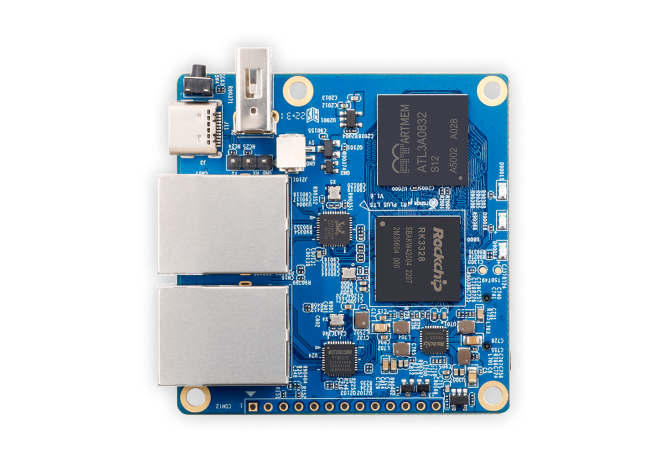

So, in a nutshell, what do you get?
There is no barrel connector for power. You are expected to power it via 5 volts (2-3 amps) over USB-C. The tiny white connector next to the console pins is for a 5 volt fan.
You might supply power via the 5V and Gnd pins on the IO header. I have not yet tried this, but a look at the schematic shows pin 1 on the 13 pin header as VCC_SYS, the same as 4 pins that come from the USB-C connector. Will one wire provide enough current?
The NanoPi R2S from Friendly Elec is an essentially identical item for $32. I don't see NAND flash included in the R2S, but it must have 16M like the R1plus because Marcin was busy replacing it with a larger chip.
I don't honestly know what the market is for tiny routers like these. That is clearly what they are designed for. For my purposes, I would gladly trade the second ethernet for eMMC. Some additional IO would be nice too, but for some reason they wanted these things to fit inside a 2.2 by 2.2 inch outline.
Other boards are available that bring out a lot more IO. Olimex has an RK3328-SOM-EVB that pairs with their RK3328-SOM module. Firefly had their ROC-TK3328-CC for $35 with plenty of IO, but it is currently not available.
If you really are itching for more IO, you might just as well jump to a RK3399 board like the Orange Pi Pi4. They are playing the same LTS game with this, so be on your toes. You can get 4G of ram and 16G of eMMC making this a much more serious board for $80 or so (a bit over double the price of the R1 plus). You get what you pay for. And you pay for what you need.
As near as I can tell the Rockchip RK3328 is just the RK3399 without the two "big" cores.
The NAND flash gives you 16 megabytes on SPI. The chip is a 128Mbit chip from MXIC (Macronix), the part number is MX25L12845G and it has an SPI interface. My board actually has a chip marked 25VQ128.
It only has a 13 pin IO header. That gives you 8 GPIO pins. Those can offer a second uart and/or a single pair of what they call TWI (which is more or less i2c). Honestly, this will do fine for many things I have in mind.
It has USB-C along with a big square traditional USB.
There is even a prominent button! What could it be? The schematic shows SW4 as an actual reset button. This is a first for Orange Pi! I have wished for this on so many other boards of theirs. How nice.
Tom's electronics pages / tom@mmto.org